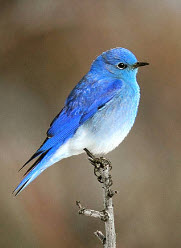Feathers serve a variety of functions:
- insulation for controlling body temperatures
- aerodynamic power for flight
- colors for communication (e.g., information on species, sex and age)
- camouflage
Modified feathers also have other roles:
- swimming
- sound production (as in American Woodcock) or muffling (as in owls)
- hearing
- protection
- cleanliness
- water repellency
- water transport (e.g., Desert Sand grouse)
-

Mountain Bluebirds have beautiful powder blue feathers on their chest, unlike Western and Eastern Bluebirds that have rusty colored feathers there. tactile sensation
- support (e.g., tail feathers of a woodpecker)
- display
Feathers host bacteria and ectoparasites. They require preening. They molt periodically. A fully developed feather is dead (with no system of nourishment or maintenance other than preening and bathing.)
Interesting feather facts:
- Red in plumage (e.g., on male house finches) comes from carotenoid pigments generated by what they eat. (Birds can not synthesize carotenoid pigments.) Females often prefer more brightly colored males, perhaps because it indicates better foraging and competitive ability, coordination, vision and health.
- Dark-colored feathers have more melanin in them, and are less likely to fray.
- The blue in bluebird feathers is produced by air-filled cavities within the keratin of the cells in the feathers. They are not iridescent like the feathers of a hummingbird, and thus the hue looks the same regardless of the viewing angle. The feathers of a male bluebird reflect a lot of UV light which makes them brighter. Feathers of females look more subdued because their structure is different. Humans can’t see UV wavelengths, but birds can.
- Brighter male bluebirds tend to pair earlier, feed young more often and fledge more young than males with weaker ultraviolet sheens (Sifferman and Hill, 2003)
- Most birds have thousands of feathers – songbirds typically have 2000-4000, 30-40% of which are on the head and neck.
- Tiny muscles raise and lower feathers and twist them or pull them closer together.
- Preening keeps feathers moist and flexible, and maintains waterproofing and insulation capabilities, and protects them against bacteria and fungi that digest the keratin in the feathers, and may discourage feather lice.
- A 44 million year old fossilized bird louse was found with feathers in its gut (Wappler et al 2004). As many as 12 species of lice may be living on the feathers of one bird. There are more than 150 species total, including chewing lice, louse flies and feather mites. When birds scratch their heads, they are probably delousing.
- Adult birds typically molt after breeding, replacing all their plumage. Feathers can change appearance as a result of wear. Starlings have spotted plumage in winter, and then as the feather tips wear off, the look changes to sleek and glossy. Some birds undergo partial molts in addition to the main annual molt.
- In some Passerine birds, males do not have full adult breeding plumage until after their first potential breeding season.
- The feather coat on a dead bird typically weights 2-3 x as much as the skeleton.
- Some birds like Tree Swallows use feathers, probably for insulation, in the nest cup.
- It is illegal to possess feathers of a protected species without a permit. See more on the Migratory Bird Treaty Act.
Sources and More Information:
- Ornithology, 3rd ed, by Frank Gill
- Ritchison, Gary, Downy Woodpecker, Wild Bird Guide, 1999
- Why are bluebirds blue?
The pure acrobatic ability of birds far exceeds that achieved by the most sophisticated aircraft.
– Dial, 1994
